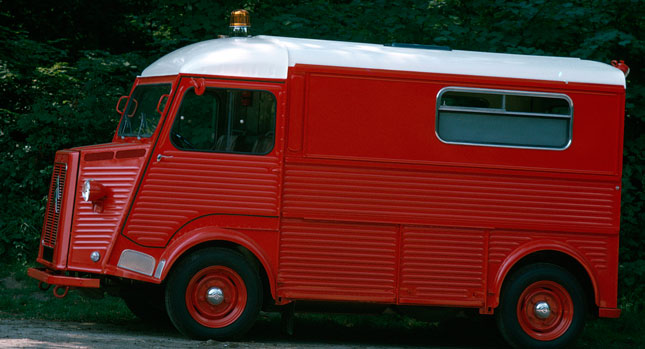If you’re into cars, chances are you will also find other types of vehicles interesting – even vans, whether they are front-, mid- or rear-engined, big or small. However, when checking out a van, one needs to look at things from a different perspective compared to the way they normally do when dealing with regular cars.
I have tried (and hopefully succeeded) in putting together a selection of vehicles that will hopefully make the concept of an interesting van clearer, as each of our nominees has been added to the list because they portray one or more traits that make them unique or special in some way.
Scroll down, and if you think that I may have missed one or more vehicle you think should be included, do comment and upload a photo of your chosen ride, be that delivery vans, step vans, minibuses or passenger models.
Citroën H Van, Type H, H-Type or HY
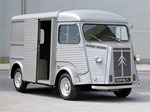 Up first we have Citroen’s unique HY van which has an unmistakable shape (especially if you’ve watched the French movie Haute Tension – spoiler alert, it’s the killer’s car), emphasized by the use of corrugated metal, which adds its own touch of coolness, as well as some structural rigidity. The HY was a real parts bin operation, borrowing its engine and gearbox from the Traction Avant, while the headlights and speedo were lifted straight out of the 2CV. It was quite prolific too, staying in production for 34 years, from 1947 to 1981.
Up first we have Citroen’s unique HY van which has an unmistakable shape (especially if you’ve watched the French movie Haute Tension – spoiler alert, it’s the killer’s car), emphasized by the use of corrugated metal, which adds its own touch of coolness, as well as some structural rigidity. The HY was a real parts bin operation, borrowing its engine and gearbox from the Traction Avant, while the headlights and speedo were lifted straight out of the 2CV. It was quite prolific too, staying in production for 34 years, from 1947 to 1981.
Renault Estafette
 Staying in France, we have the Renault Estafette, which has a droopy face that only a delivery man would love. It was made between 1959 to 1986, not only in its home country, but also in Romania, Algeria and Mexico. Renault pulled it from its official lineup in 1980, when it was replaced by the much more modern Traffic. Also, like the Citroen HY, it sold around half-a-million examples.
Staying in France, we have the Renault Estafette, which has a droopy face that only a delivery man would love. It was made between 1959 to 1986, not only in its home country, but also in Romania, Algeria and Mexico. Renault pulled it from its official lineup in 1980, when it was replaced by the much more modern Traffic. Also, like the Citroen HY, it sold around half-a-million examples.
1965 – 1978 Ford Transit
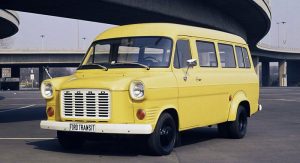 The Ford Transit really needs no introduction. The more modern ones are very common in Europe, but it’s the 1965 to 1978 model that is easily the coolest. Already in its second generation by ’65, it had American van-inspired styling, which set it apart from its rivals. In addition, boosting its cool factor were the V4 engines it was offered with, which came in 1.7- and 2.0-liter flavors, and according to Top Gear, which quoted British police sources at the time, 95 percent of all vehicle-related robberies in the UK of the 1970s were made in a Transit.
The Ford Transit really needs no introduction. The more modern ones are very common in Europe, but it’s the 1965 to 1978 model that is easily the coolest. Already in its second generation by ’65, it had American van-inspired styling, which set it apart from its rivals. In addition, boosting its cool factor were the V4 engines it was offered with, which came in 1.7- and 2.0-liter flavors, and according to Top Gear, which quoted British police sources at the time, 95 percent of all vehicle-related robberies in the UK of the 1970s were made in a Transit.
Mercedes-Benz TN/T1
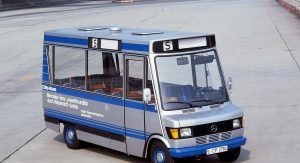 Very popular throughout Europe, and best known for its roles as rapid response vehicle, the Mercedes-Benz T1 entered active duty in 1977, and by the time it was replaced by the T1N, close to 1 million were made. In fact, it’s still being made today, under license by Force Motors of India – they call it the Traveller.
Very popular throughout Europe, and best known for its roles as rapid response vehicle, the Mercedes-Benz T1 entered active duty in 1977, and by the time it was replaced by the T1N, close to 1 million were made. In fact, it’s still being made today, under license by Force Motors of India – they call it the Traveller.
Volkswagen T1/Type 2
 The first generation of Volkswagen’s famous van and the most visually interesting of all, the T1 or Type 2 as it was also known, began its life in 1950, using the basic running gear and engine of a Beetle. This made it different to the first two vans we featured here, as those were both front-engined and front-wheel drive, whereas this was the exact opposite of that, since it also borrowed its basic layout from the People’s Car. First associated with the hippie movement in the 1960s, the T1 was seen as a more utilitarian vehicle elsewhere around the world, and for the Brazilian market, it made so much sense that they’re only just now taking it out of production there, on December 31, 2013.
The first generation of Volkswagen’s famous van and the most visually interesting of all, the T1 or Type 2 as it was also known, began its life in 1950, using the basic running gear and engine of a Beetle. This made it different to the first two vans we featured here, as those were both front-engined and front-wheel drive, whereas this was the exact opposite of that, since it also borrowed its basic layout from the People’s Car. First associated with the hippie movement in the 1960s, the T1 was seen as a more utilitarian vehicle elsewhere around the world, and for the Brazilian market, it made so much sense that they’re only just now taking it out of production there, on December 31, 2013.
Ford E-Series
 This is another historic van, whose history almost mirrors that of the European Transit, but set to a Stateside background – the Ford E-Series. Introduced in 1961 as the Econoline, it too was based on a passenger car, like its Euro counterpart, and featured quirky styling. Now in its fourth generation, the American Ford van has been in production for 21 years, but now it’s at the end of the road, and about to be replaced by a vehicle tested by robots.
This is another historic van, whose history almost mirrors that of the European Transit, but set to a Stateside background – the Ford E-Series. Introduced in 1961 as the Econoline, it too was based on a passenger car, like its Euro counterpart, and featured quirky styling. Now in its fourth generation, the American Ford van has been in production for 21 years, but now it’s at the end of the road, and about to be replaced by a vehicle tested by robots.
Chevy/GMC G-Series Vans
 The G-Series has never been the most inviting of vehicles to look at, regardless of which badge it wore (Chevrolet or GMC), but it was appreciated for its practical qualities, because, after all, it is purpose-built. Driven by everybody from park stalkers to the CIA and FedEx workers, it was built from 1964 to 1996 to serve a wide array of needs. It is its versatility that made it a commercial success, I think.
The G-Series has never been the most inviting of vehicles to look at, regardless of which badge it wore (Chevrolet or GMC), but it was appreciated for its practical qualities, because, after all, it is purpose-built. Driven by everybody from park stalkers to the CIA and FedEx workers, it was built from 1964 to 1996 to serve a wide array of needs. It is its versatility that made it a commercial success, I think.
GAZelle Van
 This is the GAZelle, from Russia, and if we take a random selection of car crash videos, we’re bound to see a few of these cutting people off, flipping over or even grinding guardrails on the highway… Launched in 1994, it underwent a major restyling in 2003, but the same basic structure remained underneath, and in 2010 it was updated again. This vehicle has no real noteworthy qualities over any other van on the market, but we thought that since these are so common in our offbeat Russian videos that it would be good to let people not familiar with it know what it is.
This is the GAZelle, from Russia, and if we take a random selection of car crash videos, we’re bound to see a few of these cutting people off, flipping over or even grinding guardrails on the highway… Launched in 1994, it underwent a major restyling in 2003, but the same basic structure remained underneath, and in 2010 it was updated again. This vehicle has no real noteworthy qualities over any other van on the market, but we thought that since these are so common in our offbeat Russian videos that it would be good to let people not familiar with it know what it is.
Mazda Bongo (First-Gen)
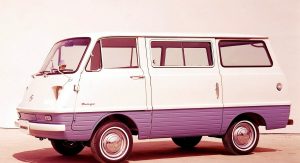 There is no way you cannot like the first-gen Mazda Bongo, due to its precious styling and lovable oh-so Japanese face. Built by Mazda from 1966 to 1975, it was available in a variety of body styles, none of which could match the passenger van variant for visual appeal. It was also pretty advanced for its day, with a 782 cc engine at the rear and a transaxle gearbox with specially low gears. It was reportedly able to carry over half a ton, despite being close to kei car proportions.
There is no way you cannot like the first-gen Mazda Bongo, due to its precious styling and lovable oh-so Japanese face. Built by Mazda from 1966 to 1975, it was available in a variety of body styles, none of which could match the passenger van variant for visual appeal. It was also pretty advanced for its day, with a 782 cc engine at the rear and a transaxle gearbox with specially low gears. It was reportedly able to carry over half a ton, despite being close to kei car proportions.
Subaru Sambar (van model based on 360 kei car)
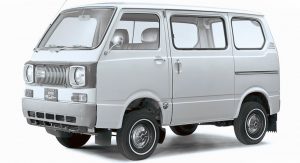 The Subaru Sambar, based on the pocket-sized 360 kei car of the 1960s, is another van we can include in the cute faced Japanese category. It too has a lovable face and small dimensions, as if it had been specially made to appeal to the side of us that likes puppies, bubbles and rainbows. This applies for the first two generations, with a production span starting in 1961 and ending in 1973, when the dreaded plastic was added, and the design flair was gone.
The Subaru Sambar, based on the pocket-sized 360 kei car of the 1960s, is another van we can include in the cute faced Japanese category. It too has a lovable face and small dimensions, as if it had been specially made to appeal to the side of us that likes puppies, bubbles and rainbows. This applies for the first two generations, with a production span starting in 1961 and ending in 1973, when the dreaded plastic was added, and the design flair was gone.
By Andrei Nedelea







